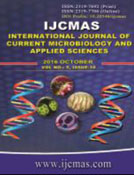


 National Academy of Agricultural Sciences (NAAS)
National Academy of Agricultural Sciences (NAAS)

|
PRINT ISSN : 2319-7692
Online ISSN : 2319-7706 Issues : 12 per year Publisher : Excellent Publishers Email : editorijcmas@gmail.com / submit@ijcmas.com Editor-in-chief: Dr.M.Prakash Index Copernicus ICV 2018: 95.39 NAAS RATING 2020: 5.38 |
Although protease, amylase and lipase are frequently studied; in the list L-asparaginase also finds position. Halophilic enzymes are currently preferred because these remains active at wide range of pH and temperature and also the yield of purified functional enzymes is high. Having studied around 29 bacteria for DNA degrading abilities; as extended part of the study these bacteria are undertaken to determine their potential for protease, amylase, lipase and L-asparaginase productions. The study included members of genera Providencia, Rheinheimera, Halomonas, Alishewanella, Serratia, Marinobacter, Marinospirillum, Bacillus, Exiguobacterium and Vibrio species. The enzymatic activities were observed in terms of detectable zones of hydrolysis which were measured. The zones of hydrolysis appeared after 24 h and were at its maximum towards 48 h. The results revealed enzyme activities largely varied among genus and within genus also. Amylase was efficiently produced by Bacillus cereus (DN3), Vibrio species (DN25), Marinobacter species (DN16) whereas excellent protease activity was exhibited by Bacillus cereus (DN3), Bacillus thuringiensis (DN2) and Vibrio Sp (DN25). Exiguobacterium (SK1 and SK2) was found to be the most efficient lipase producing bacteria followed by Providencia rettgeri (DN1) and Bacillus thuringiensis (DN2). The therapeutic enzyme L-asparaginase was produced only by two bacteria i.e. Pseudomonas (DN13) and Halomonas (DN19). Looking at industrial market of the enzymes; it is suggested that these bacteria would be promising sources of stable and robust enzymes.
 |
 |
 |
 |
 |